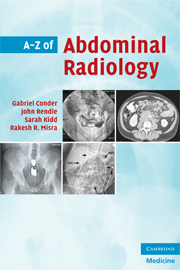Book contents
- Frontmatter
- Contents
- Acknowledgements
- Preface
- List of abbreviations
- Abdominal trauma
- Abscesses within the abdomen
- Achalasia
- Adnexal masses
- Adrenal masses
- Aortic aneurysm
- Appendicitis
- Ascites
- Bezoar
- Biliary gas
- Biliary obstruction
- Bladder calculi
- Bowel obstruction
- Calcifications
- Chilaiditi's sign/syndrome
- Cholecystitis
- Cirrhosis
- Colitis
- Colonic carcinoma
- Colonic diverticulitis
- Colonic polyps
- Crohn's disease
- Dermoid tumour
- Ectopic pregnancy
- Endometrial carcinoma
- Familial polyposis coli
- Fistulae
- Foreign bodies
- Free intra-abdominal gas
- Gallstones
- Hepatic masses
- Herniae of the abdomen and pelvis
- Intussusception
- Lines and devices
- Lymphadenopathy
- Lymphoma: abdominal
- Omental secondary deposits
- Pancreatic carcinoma
- Pancreatitis
- Portal vein thrombosis
- Portal venous gas
- Portal venous hypertension
- Pyelonephritis
- Renal artery stenosis
- Renal calcification
- Renal developmental anomalies
- Renal masses: benign
- Renal masses: malignant
- Renal tract calculi
- Retroperitoneal fibrosis
- Splenomegaly
- Testicular neoplasms
- Transitional cell carcinoma
- Tuberculosis of the abdomen and pelvis
- Uterine fibroids
- Volvulus
Familial polyposis coli
Published online by Cambridge University Press: 06 January 2010
- Frontmatter
- Contents
- Acknowledgements
- Preface
- List of abbreviations
- Abdominal trauma
- Abscesses within the abdomen
- Achalasia
- Adnexal masses
- Adrenal masses
- Aortic aneurysm
- Appendicitis
- Ascites
- Bezoar
- Biliary gas
- Biliary obstruction
- Bladder calculi
- Bowel obstruction
- Calcifications
- Chilaiditi's sign/syndrome
- Cholecystitis
- Cirrhosis
- Colitis
- Colonic carcinoma
- Colonic diverticulitis
- Colonic polyps
- Crohn's disease
- Dermoid tumour
- Ectopic pregnancy
- Endometrial carcinoma
- Familial polyposis coli
- Fistulae
- Foreign bodies
- Free intra-abdominal gas
- Gallstones
- Hepatic masses
- Herniae of the abdomen and pelvis
- Intussusception
- Lines and devices
- Lymphadenopathy
- Lymphoma: abdominal
- Omental secondary deposits
- Pancreatic carcinoma
- Pancreatitis
- Portal vein thrombosis
- Portal venous gas
- Portal venous hypertension
- Pyelonephritis
- Renal artery stenosis
- Renal calcification
- Renal developmental anomalies
- Renal masses: benign
- Renal masses: malignant
- Renal tract calculi
- Retroperitoneal fibrosis
- Splenomegaly
- Testicular neoplasms
- Transitional cell carcinoma
- Tuberculosis of the abdomen and pelvis
- Uterine fibroids
- Volvulus
Summary
Clinical characteristics
An autosomal dominant condition with 80% penetrance that is characterised by a myriad of (∼1000) colonic adenomatous polyps.
The polyps develop at the age of puberty.
Symptoms include vague abdominal pain, bloody diarrhoea and protein-losing enteropathy.
The main complication is malignant transformation. By 20 years following diagnosis, almost 100% will have developed colonic carcinoma. There is also a lesser increase in the incidence of gastric and small-bowel malignancy.
The treatment is total colectomy in the late teens or early twenties.
Radiological features
Generally now diagnosed in family members by colonoscopy, but sporadic cases may present at barium enema with a myriad of small polyps forming a ‘carpet’ throughout the colon. There may be evidence of carcinoma, often with more than one synchronous tumour.
CT colonography can reliably detect polyps of 5mm and smaller but represents a significant radiation dose in patients who are usually in their teens at the time of investigation.
Familial polyposis coli. The colon is ‘carpeted’ in multiple small polyps.
Familial polyposis coli (same patient; enlarged view of the sigmoid colon). Multiple polyps are clearly evident (arrowheads).
- Type
- Chapter
- Information
- A-Z of Abdominal Radiology , pp. 142 - 143Publisher: Cambridge University PressPrint publication year: 2009



